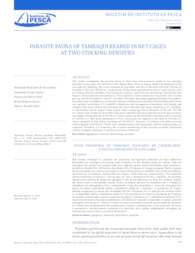Parasite fauna of tambaqui reared in net-cages at two stocking densities.
Parasite fauna of tambaqui reared in net-cages at two stocking densities.
Autoria: BAIA, R. R. de J.; SANTOS, G. G.; SILVA, A. da S. e S.; SOUSA, B. O.; TAVARES-DIAS, M.
Resumo: This study investigated the parasite fauna in Colossoma macropomum reared at two stocking densities in net-cages of a fish farm in the Matapi River, State of Amapá. Before stocking fish in the net-cages for fattening, fish were examined for parasites and also at the end of 90 and 180 days at densities of 50 and 100 fish m-3, respectively. All fish were parasitized by one or more species such as Ichthyophthirius multifiliis, Piscinoodinium pillulare, Anacanthorus spathulatus, Mymarothecium boegeri, Notozothecium janauachensis, Procamallanus (Spirocamallanus) inopinatus and Acarina gen. sp., but the dominance was of I. multifiliis. Parasites presented aggregated dispersion pattern, and there were no differences in the fish relative condition factor between the densities used. There was positive correlation of I. multifiliis abundance and monogenean abundance with length and weight of the hosts. Before fish stocking, the mean intensity and mean abundance of I. multifiliis, A. spathulatus and M. boegeri were lowest when comparing fish at densities of 50 and 100 fish m-3, which were similar to each other. The mean intensity and mean abundance of N. janauachensis was highest in the density of 50 fish m-3 when comparing the fish before stocking and at a density of 100 fish m-³. The mean abundance of P. (S.) inopinatus was highest in fish kept at 100 fish m-³ when compared to fish before stocking and 50 fish m-³. However, P. pillulare and mites occurred only in density of 50 fish m-3. There was a predominance of ectoparasites and few endoparasites, as expected. Therefore, it is necessary the constant monitoring of the parasites, to better implement control strategies aiming to avoid the occurrence of diseases.
Ano de publicação: 2019
Tipo de publicação: Artigo de periódico
Unidade: Embrapa Amapa
Palavras-chave: Fish farming, Freshwater fish, Parasites, Parasito de Animal, Peixe de Água Doce, Piscicultura
Observações
1 - Por padrão são exibidas publicações dos últimos 20 anos. Para encontrar publicações mais antigas, configure o filtro ano de publicação, colocando o ano a partir do qual você deseja encontrar publicações. O filtro está na coluna da esquerda na busca acima.
2 - Para ler algumas publicações da Embrapa (apenas as que estão em formato ePub), é necessário ter, no celular ou computador, um desses softwares gratuitos. Sistemas Android: Google Play Livros; IOS: iBooks; Windows e Linux: software Calibre.
Acesse outras publicações
Acesse a Base de Dados da Pesquisa Agropecuária (BDPA) para consultar o acervo completo das bibliotecas da Embrapa.

